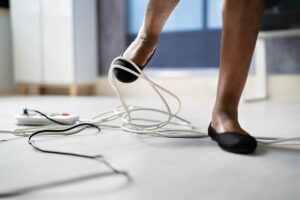 In December 2013, a severe ice storm struck the northern United States and southeastern Canada, producing freezing rain and snow. CNN reported tens of thousands of customers were without power in the below freezing temperatures, with many without power for at least four days. Two dozen deaths were related to that ice storm.
In December 2013, a severe ice storm struck the northern United States and southeastern Canada, producing freezing rain and snow. CNN reported tens of thousands of customers were without power in the below freezing temperatures, with many without power for at least four days. Two dozen deaths were related to that ice storm.
“The Federal Emergency Management Association says that winter storms are deceptive killers because most deaths are indirectly related to storms. To be truly prepared for a winter power outage, you need more than supplies. You need to know what to do when a snow or ice storm strikes.
Winter storms can severely damage power lines by weighing lines down with ice or wet snow, causing trees to fall into power lines or creating hazardous road conditions resulting in automobile accidents with power poles. All of these scenarios can create long power outages.
When the lights go out, you should first contact your electric cooperative to inform them of the outage. Phone lines may be busy. But to keep you informed, many electric cooperatives will post updates on Facebook, Twitter and their website. New smart meter systems also help most of the state’s co-ops with identifying outage areas. Once aware of an outage, they will immediately begin the assessment and restoration process. How long it takes to get your power restored depends on the extent of the storm’s destruction, number of outages, and when it becomes safe for utility personnel to get to the affected areas.
Next, get out your storm preparedness kit to help get you and your family through the power outage. This kit will need to be assembled ahead of time and should include such items as: bottled water, non-perishable food, blankets, warm clothing, first aid kit/medicine, flashlight, radio, extra batteries and toiletries.
Monitor the temperature in your home. Infants and the elderly are more susceptible to the cold. You may want to stay with friends or relatives or go to a shelter if you cannot keep your home warm.
If you are using an alternative heating source during a power outage, be sure to know how to use it safely and that you have all supplies gathered for it. Follow operating instructions, use fire safeguards and properly ventilate. Always keep a multipurpose, dry-chemical fire extinguisher nearby and know how to use it.
Use caution when using a portable generator. These should never be operated indoors because they emit deadly carbon monoxide. Additionally, never plug it into a wall outlet. This is an important precaution in preventing backfeed, which occurs when electricity travels from the generator back through the power lines. Backfeed creates danger for anyone near lines, particularly crews working to restore power.
Take steps to protect your circuits and appliances before power is restored by switching off lights and unplugging everything. Leave one light on as a quick reminder that the power is restored.

A winter storm brings a multitude of ways to sustain an injury as snow, ice and cold temperatures might linger for days. Once a winter storm front has passed, it can still be dangerous if you have to get out of the house. Stay away from any downed power lines and warn others to do the same. Car accidents can still happen on slippery roads, and more than egos can be bruised when taking a fall on icy sidewalks. Remind your family and friends to take steps now to help weather the storm safely.
For more information on weathering a winter storm, visit SafeElectricity.org.









